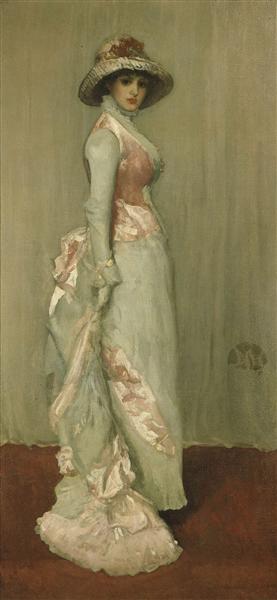Description
Within the framework of the artistic production of the late nineteenth century, James McNeill Whistler stood out for his unparalleled ability to balance composition and color, creating pieces that are both a visual delight and an intellectual challenge. One of his most relevant and evocative works is "harmony in pink and gray: Lady Meux" of 1881, a painting that captures and celebrates the very essence of the art of the portrait, infused with a subtle elegance and a sense of mystery characteristic of Whistler.
In this work, Whistler portrays Lady Meux, a controversial and enigmatic figure of the London society. The central protagonist is sitting with a relaxed but sophisticated posture, a hand supported on the back of one chair while the other falls gently on her lap. His look, almost absent, seems to go to a point outside the canvas, immersing the viewer in a contemplative state. Lady Meux is adorned with a pale pink dress, whose delicate fabric waves are wonderfully complemented by the gray background that evokes serenity and austerity. This choice of colors is not arbitrary; Whistler, known for his "harmony" theory in painting, carefully selects his palette to accentuate the emotional atmosphere of the work.
The use of color in "harmony in pink and gray" is a pure manifestation of the tonal technique that Whistler used in many of his works. The gray tones fund wraps Lady Meux in an almost intangible ethereal atmosphere, while the warm pink dress creates a soft but effective contrast, highlighting the figure without breaking the chromatic cohesion of the composition. This balance of tones is a testimony of Whistler's technical domain and its ability to create depth and texture with an apparent simplicity.
Beyond the composition and color, the figure of Lady Meux adds a layer of complexity to the interpretation of the paint. Lady Meux, born as Valerie Susan Langdon, was a courtesan turned into a lady of high society after her marriage to Barón Meux. His life was wrapped in scandal and fascination, and Whistler manages to capture this duality in his portrait. Lady Meux's calm and elegant bearing in Whistler's work contrasts strongly with the rumors and speculation that surrounded her life, creating a deep and multifaceted portrait that invites the viewer to reflect on the distance between the appearance and reality.
Whistler's technique in this portrait is also worthy of mention. The soft and controlled brushstroke confers to Lady Meux's skin an almost marble texture, in subtle contrast with the fluidity of the dress fabric. This combination of textures highlights the artist's ability to capture both the tangible materiality of objects and the subtlety of human flesh.
In summary, "harmony in pink and gray: Lady Meux" is not just a portrait; It is an exploration of color, shape and human psyche. Through his deliberate choice of tones and his precise technique, Whistler not only introduces us to Lady Meux, but invites us to deepen the nuances of his personality and his historical context. This work is erected as a lasting testimony of Whistler's artistic genius and his unique approach towards the representation of his subjects, ciming his legacy both in the field of portrait and in art in general.
KUADROS ©, a famous paint on your wall.
Hand-made oil painting reproductions, with the quality of professional artists and the distinctive seal of KUADROS ©.
Art reproduction service with satisfaction guarantee. If you are not completely satisfied with the replica of your painting, we refund your money 100%.

